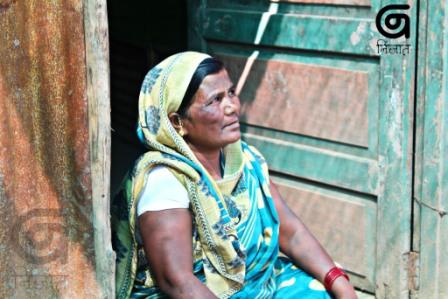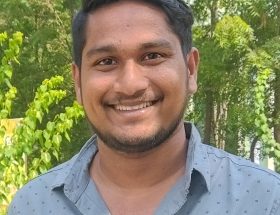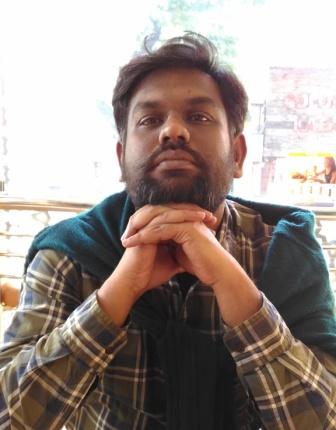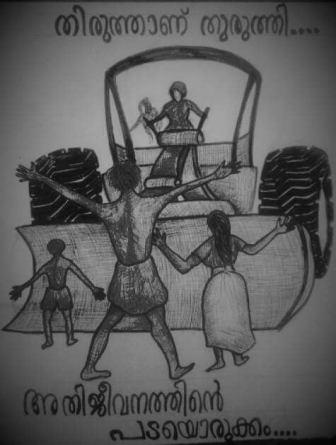Omey Anand
Human beings are always in search of meaningful existence and once someone realizes the essence of existence, fighting for it becomes clear and justified. The ongoing valiant protest against CAA and NRC signifies the accumulated anger and growing fear among minorities on the one hand and symbolises existential struggle on the other. This organic struggle is primarily focused on the pertinent question of existence and recognition. The heterodox tradition in India begins on this line when Buddha realized the principle of existence and gave an emancipatory framework to everyone. His Dhamma is not fixed and rigid; it provides autonomy and flexibility in the rapidly changing and transforming realities. Babasaheb later refined it and conceptualized it as Navayana which ultimately seek to establish a democratic societal order which is free from all sorts of servitude, oppression and subordination and recognizes equal worth and dignity of individuals.

Babasaheb measures the progress of any society by the degree of freedom and progress women have achieved in that society. When we look around today, we come across thousands of Dalit women striving hard for meaningful existence and confront their multi-layered struggles in a quest for survival. They create and recreate their struggles in everyday life with minimum means at disposal and express firm faith in the project of meaning making. Kadubai is one among them, living a strenuous yet confident life in the hope of making things better. Her struggle for a biological and meaningful existence tells us two independent stories that we need to take serious note of.
I find Dalit artists as philosopher friends. Nobody could tell us about Babasaheb more beautifully than them. Their traditional musical instruments like ‘Halgi’ (made of animal carcass which dalits used to dispose) reminds us of our not distant caste oppression while the ‘Ektara'(another instrument used by Dalit-Bahujan artists) tells us their civic militancy against caste, class and gender based inequalities. I met Kadubai when I was searching for invisiblized sounds of these instruments in today’s globalized world. When we are busy in discovering and investing in our ‘self’, she was selflessly professing the emancipatory thoughts of Babasaheb Ambedkar through her songs on Ektara. Her voice intimately connected me to the rich anti-caste cultural legacy of Vaman Dada’s revolutionary ‘Ambedkarite Songs’, Annabhau Sathe’s ‘Duff’ and Vilas Ghogare’s ‘Ektara’.
In a quest to record this history, I wanted to tell Kadubai’s unheard and invisiblized story in audio-visual mode. But when I went to ‘arrest’ Kadubai in camera, her residential locality was constantly reminding, and disturbing me, of the immediate oppressive past which victimized Annabhau, Vamandada and Vilas. Recollecting their painful struggle towards the end of their life, I was loaded with lots of unanswered questions and wanted to seek answers. So I decided to pursue it in Kadubai in the midst of all hardships I faced, like every dalit artist.

Normally the artist’s role is confined to entertain people. But when the motive is political, the artists take charge and immensely contribute to the social revolution in making. With their participation and contributions, social movements sometimes garner larger mass support and benefit a lot. But the fundamental questions of tthe artist’s existence remain unanswered. Both the movement and people are less concerned about their questions related to ontological existence–such as where they live, what and how they eat etc. and fail to see the artist’s life world beyond entertainment.
Similarly, Kadubai became a popular sensation, ringtone and status of thousands of Dalit activists, students, politicians and sympathizers overnight. She gets thousands of likes and downloads but that doesn’t end her routine struggle of going door to door, begging in Mukundwad and many other localities. She doesn’t seem excited and attracted by the camera like us; rather she is more concerned about her daughter Chakuli’s education and son Vikas, who goes for construction work to help Kadubai in eking out everyday survival. Planes and trains pass by where Kadubai lives but it does not help her as she is faced with the immediate existential question of raising her family, and begging is the only option available to her.

The documentary ‘Kadubai’ speaks about this. Drawing on the legacy of Dadasaheb Gaikwad’s land rights struggle, this documentary presents the immediate question of land struggle by Kadubai and people around her. It reminds us of our social responsibility and knocks on our social sensitivity about everyday material struggles of the artist together with her internal world full of disturbing questions. It captures the people around Kadubai, equally worth mentioning, and expresses dissent against the popular culture which heavily invests in making Kadubai a mode of entertainment. Her songs are praised and streamed live by mainstream channels and organisers but they do not get disturbed by her immediate questions of housing, Chakuli’s education and Vikas’s aspirations. They does not ask the question of why 700 people, along with Kadubai, continue to live on ‘Notice’ and fear undesired eviction by the local municipal corporation. The continuous shower of fame does not change Kadubai’s choice of struggle. Despite receiving huge fame, Kadubai makes a conscious choice of organising a struggle for recognising land rights and remains firmly connected to her ontological site of existence by continuing to stay with the same three hundred people without water, light and a safe shelter. They eat together and spend hours deciding on the next move to protect and rebuild their houses dismantled by the local administration.
Kadubai’s recent embrace of Buddhism, along with other members from her community, signifies not only her quest for a meaningful life but also the desire for organising collective struggles–by making people around her equal participants. It captures their sense of citizenship and claims on entitlements guaranteed by law, and the firm belief in the constitutional methods of organising struggles and securing justice. Her protests take her towards finding new meaning of life, which can either be the Buddha or the Void.
Kadubai’s voice has the ability to illuminate truth, both personal and political.
~~~
Omey Anand is a filmmaker, and a student of the School of Media and Cultural Studies, TISS, Mumbai.










